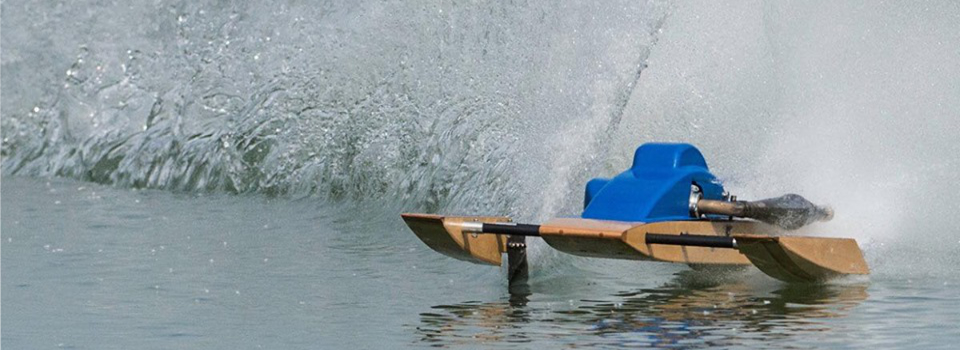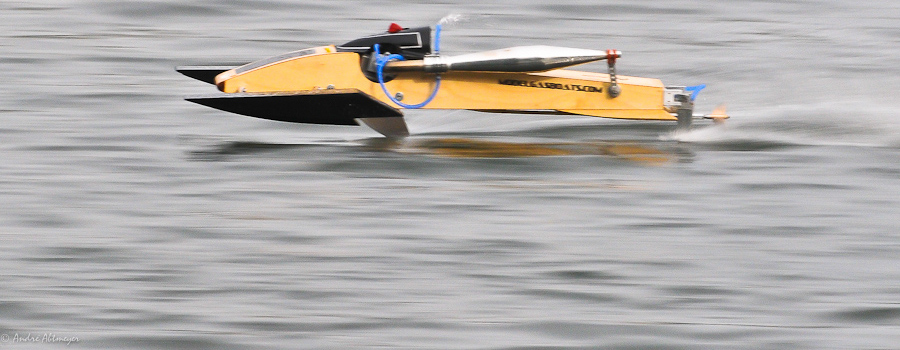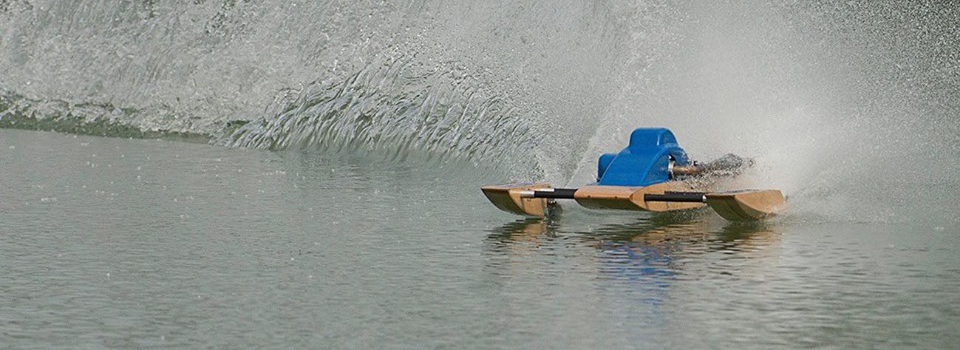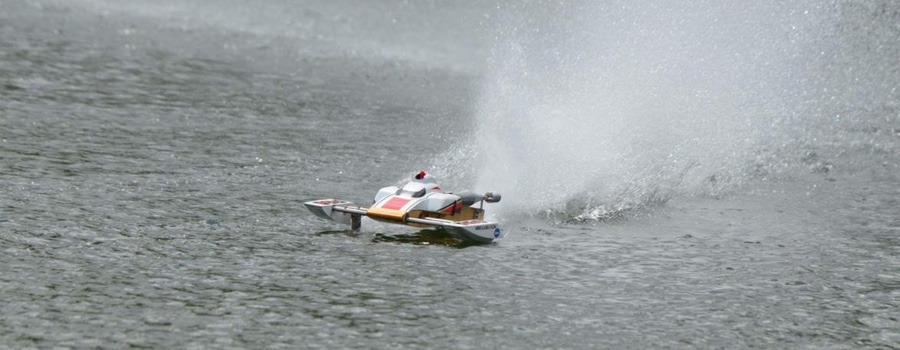General Tips
Handling small screws
- When trying to install some small screws, instead of looking for the magnet-tip screwdriver (stainless steel won't stick to a magnet) use a dab of grease on the tip of the driver to hold the screw in place till you get it started.
Wayne Rathbun (6/2002)
- Big fingers little screws? Slip a small piece of fuel line over the tip of the screwdriver, hex wrench, etc...push the screw into the fuel line. This will hold the screw or small bolt on the tool !
Chas Copeland
Crackerbox Setup Info
Nelson King (ndking88 on Jim's RC Boat Dock) was kind enough to share his experience with a reader that had some questions regarding a Crackerbox boat. The questions and answers are below, along with some pictures that were provided - editor
 Hi
Glowplug41, I am ndking88 and will attempt to provide the information you have
requested. I have only built one Crackerbox so I don't consider myself an expert
in the design and setup of a Crackerbox but I have raced against some of the
best so here goes:
Hi
Glowplug41, I am ndking88 and will attempt to provide the information you have
requested. I have only built one Crackerbox so I don't consider myself an expert
in the design and setup of a Crackerbox but I have raced against some of the
best so here goes:
Q. I need to know where the CG should be?
A. This is difficult to answer since it will vary based on the design of your boat. If your design has a fair amount of rocker at the keel and chine a CG of 28% to 30% of the overall length measured from the transom seems to work well. For a boat with a straight keel the CG could be farther forward. How far forward will depend on the deck configuration. For a flat, level deck that provides no down force at speed the CG should be further forward than if the deck slopes toward the bow. In this case the CG could be from 30% to 35% of the overall length. A safe bet would be to place your CG at 30% and make small additions of weight to the bow or stern as needed.
Q. Where should I place the skeg or fin?
A. First
lets examine what a skeg does. Without a skeg it would be near imposable to turn
your 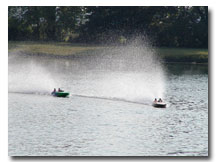 Crackerbox. Due to the relatively flat bottom a CB would slide
sideward and not respond to rudder input so the skeg is needed to provide a
pivot point to turn on. The skeg needs to be deep enough to stay engaged in the
water, especially in the turns, but not so deep as to trip the boat to the side
should it skip over another boats wake. As for placement almost all the boats I
have seen have the skeg placed at or near the CG. From my experience, I prefer
the skeg placed a little farther forward. A boat that has the skeg close to the
stern (and rudder) will be skittish with radical response to the rudder input.
Placing the skeg 4" to 6" forward of the CG will reduce this tendency.
Crackerbox. Due to the relatively flat bottom a CB would slide
sideward and not respond to rudder input so the skeg is needed to provide a
pivot point to turn on. The skeg needs to be deep enough to stay engaged in the
water, especially in the turns, but not so deep as to trip the boat to the side
should it skip over another boats wake. As for placement almost all the boats I
have seen have the skeg placed at or near the CG. From my experience, I prefer
the skeg placed a little farther forward. A boat that has the skeg close to the
stern (and rudder) will be skittish with radical response to the rudder input.
Placing the skeg 4" to 6" forward of the CG will reduce this tendency.
Q. Is a Homlite 22cc enough motor?
A. Enough for what? From my observations a stock, air-cooled motor of that size can provide hours of enjoyment. However if you intend to compete in sanctioned events you may want more power. I have a half dozen or more plaques and trophies from events I have competed in running a modified 25cc Homelite. There is more to winning than speed.
Q. What props would be good?
 A. Wow,
there are a lot of variables that influence prop selection. This will depend on
available power, hull configuration, hardware used, drive configuration and
purpose to name a few. Assuming the engine you plan to use is stock or near
stock either a Octura X470 or Prather 270 would be an inexpensive prop to start
with.
A. Wow,
there are a lot of variables that influence prop selection. This will depend on
available power, hull configuration, hardware used, drive configuration and
purpose to name a few. Assuming the engine you plan to use is stock or near
stock either a Octura X470 or Prather 270 would be an inexpensive prop to start
with.
Q. What should it weigh?
A. I have seen CB boats from 14lb to 20lb plus. Personally I don't feel that lightweight is necessarily better and believe too much is made of that. Mine is 18lb+ and I am very happy.
Q. Does
anyone have a crackerbox up in your part of the country?
Could someone send
me a picture of their CrackerBox?
Could someone send me pictures of a
crackerbox actually running?
Does anyone race these?
Any basic feed back
on CrackerBox?
A. I'll
try to sum these up for you. I am in Northern Ohio and the club I belong to had
only two boats of this class two years ago and now there are 6 or 7 and I know of at
least two more being built. They are becoming quite popular here. I am also
aware of regional and national events where up to 20 CB have registered for
competition.
boats of this class two years ago and now there are 6 or 7 and I know of at
least two more being built. They are becoming quite popular here. I am also
aware of regional and national events where up to 20 CB have registered for
competition.
I hope the information provided here helps and that you have hours of enjoyment with your Crackerbox.
Nelson
King (9/2003)
This email address is being protected from spambots. You need JavaScript enabled to view it.
Alternate Retrieve Boat
See the original article
on Retrieve Boats here.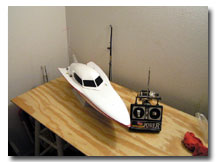
After a
couple months of trying to make a reliable retrevial boat out of the Zig Zag,
I'd had enough!! That's it! I went to EBAY! EBAY can be you're friend! I found
this boat on the block. It was Sunday morning, and the bidding was up to a
whopping $15.00. With 10 mins to go, I bid $20.00 and made breakfast. 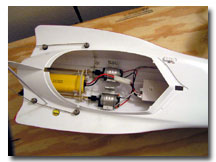 I came
back and found that I'd won! My few keystrokes, cost me $17.01
I came
back and found that I'd won! My few keystrokes, cost me $17.01
Then the bad news was they wanted $28.00 to ship it from Calif.! Oh well, still under fifty bucks! HA! I took the "quick release reel" I had on the Zig Zag transmitter off it.
Then I made up a mount for the reel, on the new transmitter.
Then, remembering the twisted up fishing line on the Z/Z, I decided to make a change. At work, on a Bridgrport mill, with a digital readout, I made a wire bending jig. Using 3/16" dia roll pins. The result is the outrigger you see hanging off the back of the boat.
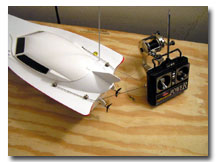 The
radio in this boat is far far away from the transom. And draging the radio thru
the water isn't even an issue! Of course being 29" long, is a help too. I
remember the Zig's nose, just barely poppin otta the water on a couple of
retrevials!
The
radio in this boat is far far away from the transom. And draging the radio thru
the water isn't even an issue! Of course being 29" long, is a help too. I
remember the Zig's nose, just barely poppin otta the water on a couple of
retrevials!
I guess what I'm sayin is- DON'T WASTE YOU'RE MONEY ON A ZIG
ZAG! GO TO EBAY AND SAVE!!!
Brian Madigan

